From Lychees Online
by Krystal Folino and Bill Mee
Flowering in
Lychee Trees
PART 1: Introduction to Lychee Flowering
PART
2: Flower Bud Formation and Differentiation
PART
3: Flower Panicle Development
PART
4: Lychee Flower Types and Anatomy
PART 5:
Flower Pollination
PART 6:
Pest of Flowers
PART 1: Introduction to Lychee Flowering
Lychee Fruit
Develops from Pollinated Flowers:
Flowers,
in particular the female flower, is the predecessor to a lychee fruit.
When the ovary of a female flower comes into contact with pollen from
male flowers an embryo will develop into a lychee fruit, provided
pollination is successful. Most lychee varieties do not flower or fruit
consistently every year and others, especially the non-commercial
varieties, may go many years without producing much fruit.
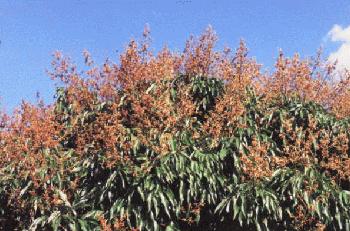
Fig. a
'A Brewster' tree in full bloom
Lychee
Flowers Develop During Winter Growth Flush:
Flowering
in lychee trees occurs once a year in the winter and happens during one
growth cycle in the year round continuous growing process. Lychee trees
must flower, pollinate and fully complete fertilization during this
cycle for there to be fruit set. Understanding this process is a key
factor in managing lychees for optimal fruit production.
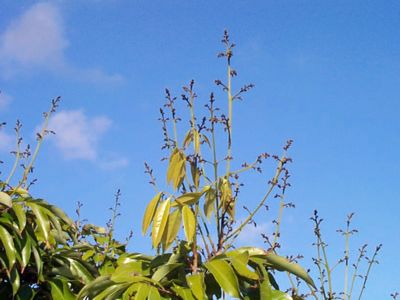
Fig. b
'Mauritius' early flower panicle emerging from terminal branch
Lychees
grow in "recurrent terminal flushes", which means that they grow from
the end of branches in periodic spurts separated by short intervals of
dormancy. Young lychee trees flush as many as 5-6 or more times a year
whereas mature fruit bearing trees flush several times a year with a
bloom flush in the winter. The interval of dormancy between successive
flushes is 6 weeks minimum and can be much longer depending on the tree
size, age, weather conditions, growing conditions and variety, etc.
PART 2:
Flower Bud Formation and Differentiation
Your
tree(s) must experience bud break of 2mm to 4mm during an extended
period of cool weather. Lychees flower during the cooler winter months
as it is during this time that the mean temperatures can consistently
fall below the 68 degree threshold required for bloom formation
(November - February in the northern hemisphere and April - August in
the southern hemisphere) During a warm winter (average temperatures
above 68 degrees) most lychee trees will grow vegetatively and not
produce flowers.
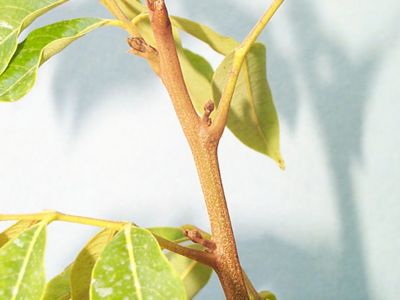
Fig. 1a
Picture of emerging bud
It
has been generally established that if the mean daily temperature is
above 20 degrees C (68 degrees F) new growth will be vegetative (i.e.
leaves and branches) whereas if the mean temperatures are below this
temperature flower panicles will form from emergent buds. This process
is known as flower bud differentiation and is a function of internal
plant hormone levels, environmental conditions and temperature. When
the buds first emerge they are a mixture of flower and leaf buds. As
the bud continues to grow the leaves fall off and an inflorescence
develops if the temperatures remain low. If the temperatures remain
high a mixed inflorescence with both flowers and leaves can develop.
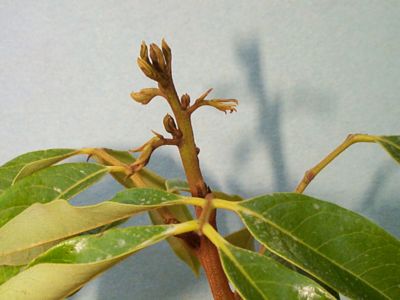
Fig. 1b
'Mauritius' terminal bud break showing signs of differentiation
If
you are thinking that a solution to getting flower panicles during the
winter months is to force bud break by pruning prior to the onset of an
extended cold period, think again. The problem with this approach is
that the remaining leaves left after the pruning are too old to support
a good crop because the photosynthetic capacity and nutrient and energy
output of the leaves diminishes with age. Lychee tree leaves have a
finite lifetime and are shed from the tree periodically.
If you
are faced with a situation of winter vegetative growth flush you can
selectively pinch prune the growth flush thereby leaving some new
leaves to support fruit development if subsequent bloom panicles emerge
following the pruning. A better strategy is to time your postharvest
pruning so as to insure bud break during the cooler season.
PART 3: Flower Panicle Development
When
a lychee tree flowers the flower panicle emerges 4-6 weeks after
initiation has taken place as a showy multi flowered cluster, known as
a panicle, on the end of branches (terminal inflorescence). In Florida,
flower buds emerge in December and sometimes as early as November. The
buds develop into a panicle during December and January. The flowers
which are borne on these panicles develop from February through March.
Fruit resulting from trees which flower very late in the cycle often to
not fully mature.
A fully developed panicle consists of a main
stem or spine known as a rachis with lateral (axial) branche. These
branches are covered with one or more spikelets each having three small
greenish yellow non-fragrant flowers approximately 2 to 3 mm in length.
Lychee flowers do not have petals, but they do possess the typical
anatomical components of a flower: ovary, style, stigma anthers. A
panicle can be 1 to 1 ½ feet in length or more long and have as
many as 3000 flowers, although only a small percentage of these are
ever pollinated (100 - 200).
An example of a flower panicle is shown in Fig. 1c
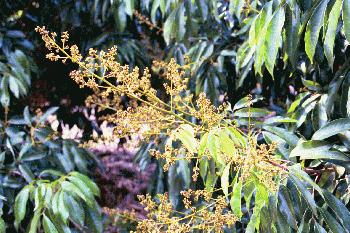
Fig. 1c
A Flower Panicle of the 'Brewster' Variety
The
earlier in the winter a lychee tree flowers the more time the panicle
has to elongate and develop and the more fruit the panicle can
potentially produce.

Fig. 1d
'Mauritius' mixed infloresence with both flower and leaves
PART
4: Lydhee Flower Types and Anatomy
There
are three types of flowers of varying distinct sexual forms occurring
in lychees. They all form on the same panicle and mature at different
times over a two to six week period on most cultivars. Plants that have
flowers of both sexes occurring on the same plant are referred to as
heterogamous. The ratio of different flower types varies among
cultivars and can affect the amount of fruit setting during a season.
The three stages of development are as follows:
Male flowers open and release viable pollen
Hermaphrodite females flowers open which set fruit if pollinated
Male hermaphrodite flowers open and shed viable pollen.
An hermaphrodite flower is one having both male and female parts in the
same flower.
The
male and male hermaphrodite flowers produce the pollen that fertilizes
the females, although the male flowers in the third stage are most
responsible for fertilization as the anthers of these flowers tend to
shed the most viable pollen. Julia Morton's book Fruits of Warm
Climates, suggests that non-viable or damaged pollen may result in
abortive seeds. The resulting seed is small and shriveled and often
referred to as a "chicken tongue seed."
Lychee Flower
Types:
Male flowers:
Male
flowers usually have 7 - 9 stamen filaments connecting to the base. The
pollen bearing anthers are attached to these long filaments. An example
is shown in Figure 2a,b,c. When the pollen is ripe the anthers turn
yellow and break open to release the pollen to fertilize the female
flowers. Each anther may produce several thousand grains of pollen.
When the pollen comes into contact with the stigmatic surface of the
female flower the pollen germinates and forms a tube which penetrates
into the stigma and then the ovary. Lychee flowers open primarily
during the daytime from 8 am to 4 pm.
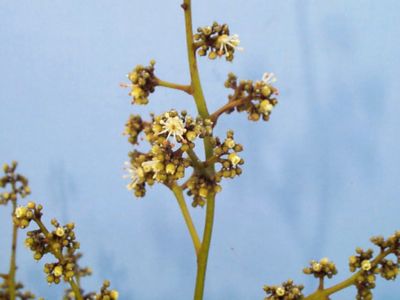
Fig. 2a
Male 'Mauritius' flowers in full bloom with ripe pollen
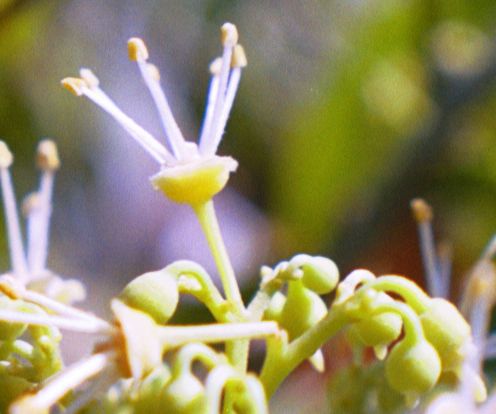
Fig. 2b 
Male 'No Mai Tze' flowers with ripe pollen and
unopened females
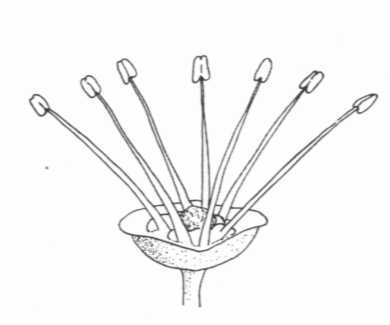
Fig. 2c
Detailed Diagram of a Male Flower
Diagram
Courtesy of Agrilink: Department of Primary Industries, Queensland
Horticulture Institute
Hermaphrodite
Female Flowers:
Fig.
3a,b,c,d shows fully developed hermaphrodite female flowers with three
distinctly differentiated well developed female parts: ovary, style and
stigma. You will note the two distinct atria on most of the female
ovaries. The female flower also has stamen with pollen sacs that never
open to release pollen and degenerate. Female flowers usually open in
the earlier morning from 7 - 8 am and again in the afternoon between 2
- 5 pm. The stigmatic surfaces are stickiest and most receptive
immediately after they open.
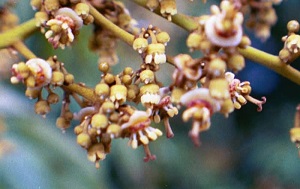
Fig. 3a 
Fully developed hermaphrodite female flowers -
Note the fully developed anthers, stigma and style
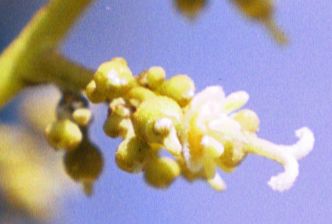
Fig. 3b
Fully
developed hermaphrodite female just opened flower on the 'Sweetheart'
variety - Note the ovaries and receptive stigmatic surface. Flower has
probably not been pollinated
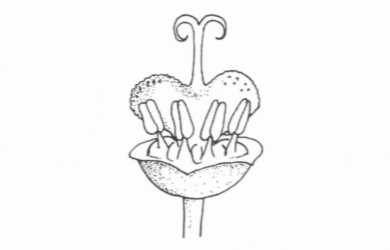
Female flower diagram showing the distinctive parts: stigma, style,
ovary and pollen bearing anthers
Diagram
Courtesy of Agrilink: Department of Primary Industries, Queensland
Horticulture Institute
Hermaphrodite
Male Flowers:
Hermaphrodite
male flowers have degenerated pistils (the receptive female part that
has a stigmatic surface that receives pollen) with undeveloped ovaries
and no stigma on their styles. These cannot form fruits. An example of
this type of male flower is shown in Figure 4. You will note that the
male flower to the left and right of the already fertilized female
flower at the top of the photo clearly display the degenerated pistils
and undeveloped ovaries.
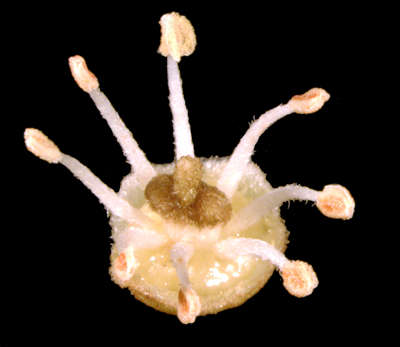
Fig. 4a
Hermaphrodite 'Mauritius' male flowers with ripe pollen - Note the
vestigial ovary in the center of the stamen
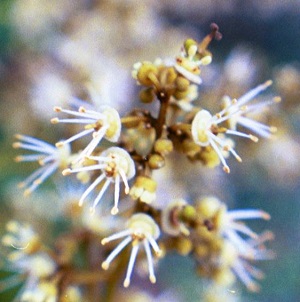
Fig. 4b 
Hermaphrodite
'Brewster' male flowers with ripe pollen - Note the degenerated ovary
of the male flower in the upper right hand side - Note also the
pollinated female on top whose stigma is degenerating
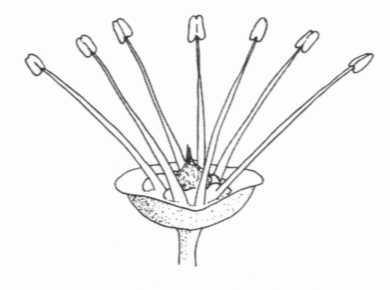
Fig. 4c
Hermaphrodite flower diagram showing the distinctive parts: stigma,
style, ovary and pollen bearing anthers
Diagram
Courtesy of Agrilink: Department of Primary Industries, Queensland
Horticulture Institute
PART 5: Flower
Pollination
There
must be an overlap of the stages in order to assure good pollination.
On a single tree panicles emerge and develop at different times. This
insures that there will be pollen available to fertilize female flowers
and obtain good fruit set assuming that there is a pollinator like bees
to carry the ripe pollen from the male to the female flowers. Having
multiple trees, such as in a grove situation, or having a tree of a
different cultivar with different stages of panicle development assures
that there will be improved overlap of pollen bearing male flowers with
receptive female flowers.
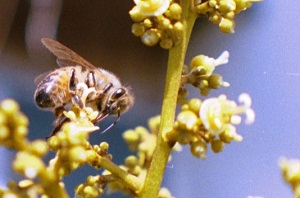
Fig. 5 
Bee taking nectar from the calyx gland of a
lychee female flower.
To
a small degree you can get some minimal wind pollination, but insects
such as bees, wasps, beetles and flies do most of the work. In
particular, honeybees, are the primary carriers of pollen and for good
fruit set care should be taken to maintain bee hives around a grove.
The bees are attracted to the nectar which is secreted in the morning
by a gland within the base (calyx) of the flower to which the stamen
and pistils are attached.
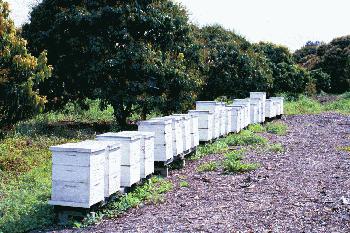
Fig. 6
Typical beehives in a lychee grove
Bee hives in a typical grove - Note the removal of most vegetation away
from the area around the hives.
You
should consult the services of a professional bee keeper (apiarist) if
you plan to maintain bees in your grove. Keeping bees is a science in
and of itself. There are many insect predators that affect bees, such
as hive beetle and wax worm and for effective grove management you need
an apiary professional.
The honey that is derived from the
nectar of lychee flowers is a very superior variety. Unlike citrus
based honeys lychee honey does not crystalize. The color is darker than
orange blossom honey and the flavor is very pleasant.
Lychees
can be artificially pollinated. The ripe pollen must be collected by
lightly tapping male flowers onto a towel and washed into a solution
which can then be immediately prayed on the receptive female flower
clusters.
PART 6: Flower Pests
Depending
on where in the world lychees are grown there are different pests that
affect the flowers. In China lychee brown blight is one of the most
serious diseases. This is a fungal pathogen whose spores infect
panicles when it is rainy causing them to dry up and turn brown.
Anthracnose can damage lychee flowers if we experience heavy rains
during the winter which is usually not the case in Florida. Anthracnose
can be controlled through the use of approved fungicides; however
fungicides can destroy essential soil mycorrhizal fungi that are an
important symbiont for lychee tree roots and should probably be avoided.
The
most significant pathogen affecting both Australian and Florida lychee
growers are flower caterpillars. In Australia there are caterpillars of
the moth species Isotenes
miserana and Platypeplus
aprobola and they feed on the flowers and young fruit.
In Florida the adult webworm moth (Crocidosema
sp.). oviposits (lays eggs) on the apical buds of flower panicles or
new growth. It is believed that this moth was introduced into Florida
from the Caribbean. The eggs hatch and the larvae may bore into the
succulent new growth or feed on newly emerging flower parts. Symptoms
of damage include webbing of newly emerged panicles or leaves. Very
small, recently set fruit (green, pea size) may also be bored into and
under close inspection may show an entry hole. The moth populations
begins to build up during November and peaks during January and
February, which unfortunately peaks during the critical phase of the
lychee flowering season.. There are no alternative host plants that
this moth feeds on and the population of this pest appears to be
coincident with the flowering and flushing cycle of lychees and longans.
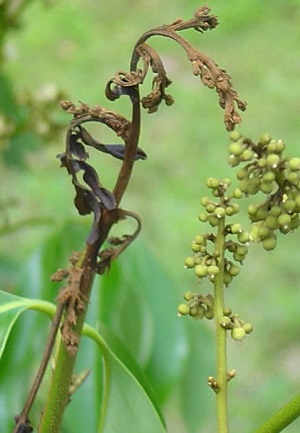
Fig. 7
Lychee webworm damage to a flower panicle
Parasitic
wasps are being tested for use as a bio-control for this moth species,
but most growers are using an insecticide known as Intrepid 2F, which
is effective in controlling lepidopteran pest (moths).
Intrepid
2F is manufactured by Dow Agrosciences and has been approved by the EPA
for use on lychees and longans. The active ingredient in Intrepid -
methoxyfenozide - mimics the natural insect molting hormone, inducing a
premature lethal molt of the larvae within hours of ingestion. Intrepid
offers extended residual activity of at least 14 days on treated
foliage.
Supposedly Intrepid 2F has not demonstrated any
toxicological effects to most beneficial insects, mites, and
pollinators such as lady beetles, lacewings, parasitic wasps, and bees.
Intrepid
2F has low toxicity to mammals, birds, and fish, but is toxic to
aquatic invertebrates. Please remember that a wide variety of
invertebrates comprise the inter-related eco-systems of the soil food
web and use of topical pesticides may have a very adverse affect on
soil health. A certain percentage of what gets sprayed topically ends
up in the soil around a tree so you should remember this before using
any insecticides.
While you may solve the immediate problem of
caterpillar larvae you may be causing serious damage to the environment
essential to good root system health.
Another insecticide Admire
2F (imidacloprid) has a similar mode of operation however this compound
is highly toxic to honeybees and should not be used on lychees for
obvious reasons.
by Bill Mee and Krystal Folino - Lychees Online
Back to
Lychee Page
|
|
Bibliography
Folino, Krystal and Bill Mee. "Flowering in Lychee Trees,
Part One, Two, Three, Four, Five and Six." lycheesonline.com.
N.d. Web. 24 Jan. 2014.
Photographs
Fig. a,1c,2b,3a,3b,5,6,7 Folino, Krystal and Bill Mee. Flowering
in Lychee Trees, Part One, Two, Three, Four, Five and Six.
N.d. lycheesonline.com.
Web 3 June 2014.
Fig. b,1a,1b,1d,2a,4a,4b Maguire,
Ian. Mauritius
Lychee. N.d. trec.ifas.ufl.edu.
Web. 3 June 2014.
Published 24 Jan. 2014. LR. Last update 3 June 2014 LR
|















